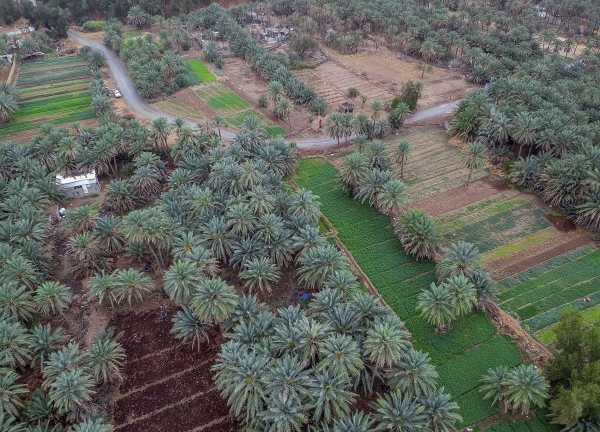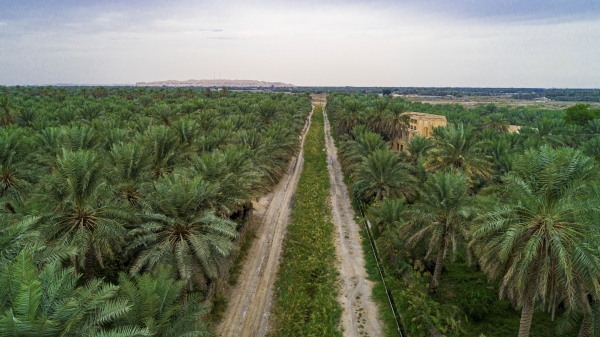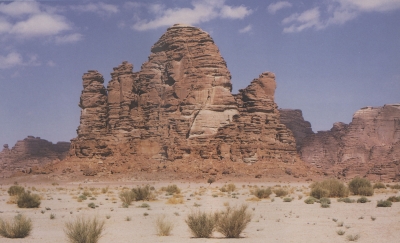

Palms Areas in the Kingdom of Saudi Arabia refer to the agricultural lands suitable for date palm tree cultivation in the Kingdom of Saudi Arabia. Palms cultivation is common in most of the regions of the Kingdom, except in the Sarawat Mountains and southern Tihama. These regions lack the climatic conditions required for palm cultivation. Nonetheless, some palm trees are scattered across these regions.
Agricultural areas that are suitable for the cultivation of palms are divided into three groups based on the factors of soil, climate, and water availability:
Palms in the eastern oases
The eastern oases comprise al-Ahsa Oasis, the most renowned palm oasis in the Arabian Peninsula, al-Qatif Oasis, and Yabrin Oasis. Al-Ahsa Oasis houses twenty-five date cultivars, some of which are eaten dried, such as Raziz, Shibibi, Shishi, Hatemi, and al-Khalas dates, which is the most expensive date cultivar. These varieties rank first in terms of quality and storability. Some other cultivars ripe early, such as al-Gharrah, al-Tayyar, al-Kasbi, Umm Rahim, and al-Hulaili dates. These varieties are eaten ripe or fresh. Other date cultivars ripe late, and thus are eaten ripe. These include al-Shahal, al-Hilali, al-Tanajib, and al-Khusab dates.
Dates cultivated in al-Qatif Oasis amount to around thirty-five cultivars. They are of a lower quality than those cultivated in al-Ahsa. This is due to soil salinity and air humidity. Varieties include Bakirah, al-Khunaizi, Khuseb Raziz, al-Gharrah, Khuseb Hussein, Khuseb Asfur, al-Khalas, al-Khadrawi, al-Shibibi, and Mawaji dates.
Palms in the northern and central oases
Northern and central oases span from al-Jawf and Hail to the north through Wadi al-Dawasir. They cross the regions of al-Qassim, al-Sir, al-Washm, Sudair, al-Zulfi, al-Aarid, Riyadh, al-Kharj, Howtat Bani Tamim, al-Hariq, and al-Aflaj. Many varieties of dates are produced in al-Jawf and Hail, including Halwa dates, the finest variety, followed by al-Hamraa dates, al-Rukhaimi, Deqlah Khalaf, al-Khudri, al-Medjhoola, and al-Qasaba dates, the most cultivated date variety.
Al-Barhi dates, cultivated in al-Qassim and al-Sir, are among the finest date varieties. al-Shaqraa dates are the most prominent cultivar. This is due to their storability. Al-Maktoomiah dates, large egg-like yellowish fruits, rank second and are eaten fresh, ripe, and dried, followed by al-Sokkariah white dates or al-Sokkariah red dates (Sokkariah al-Mothannab), in addition to Usaylah, al-Rawthanah, and Nabtat Ali dates.
Various cultivars of dates are cultivated in the governorates of al-Zulfi, Sudair, al-Aarid, and other areas of the central region. Varieties include al-Maskani, al-Maqfaziah, Umm al-Hamam, Umm al-Khashab, al-Dukhaini, al-Saqi, al-Salaj, Umm al-Kibar, Nuboot Saif, al-Wananah, al-Safri, al-Numaifi, al-Qatara, al-Sirri, al-Thawia, and al-Burni dates. Al-Khudri dates rank first among these varieties, due to their nice taste.
Palms in the western and southwestern oases
The western oases in al-Madinah al-Munawwarah comprise the oases of Yanbu, Khaybar, and al-Hait, where more than two hundred varieties of palms are cultivated. These oases surpass other oases in their number of palm trees, cultivars, and quality. Some of the trees in the area experience multiple fruiting a year. Varieties cultivated in the area include al-Burni, al-Rabiah, al-Safawi, al-Shalabi, al-Shaqraa, al-Shawq, al-Anbara, Rawathanat al-Madinah, al-Hulwah, al-Wananah, al-Baydaa, al-Mishawakah, Rawathanat al-Sharq, Sokkarat Yanbu, Basataa, Rubaei, and Ajwat al-Madinah dates.
Southwestern oases comprise the oases of: (Bishah, Ranyah, northeastern Abha, Turbahat al-Baqqom, al-Kharmah at the east of Taif, al-Aqiq town at the east of al-Bahah, and Thee Ain in Tihamah, al-Bahah). The area, where similar varieties are cultivated, is known for its large number of date palm trees. Notable cultivars of the area include al-Safri, al-Burni, al-Sirri, al-Khudri, al-Lahaq, Budairah, and al-Muqfazi.
Najran is one of the most important date-producing regions. Date palm trees are planted in the four directions of farm edges. However, date palm tree cultivation in the central area of Najran is minimal, as most agricultural lands are dedicated to wheat and barley. Notable cultivars of the area include al-Bayad, al-Burni, and al-Uluq dates, in addition to al-Ahmar dates, which are the lowest quality and are not served to guests.
Related quizzes
Related articles


